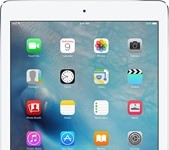 When I visited Irex Technologies, the creators of the E Ink-based Iliad e-book reader, I brought along a print-out of the questions our readers asked earlier. Answers below the fold.
When I visited Irex Technologies, the creators of the E Ink-based Iliad e-book reader, I brought along a print-out of the questions our readers asked earlier. Answers below the fold.
To be honest, I thought it was a bit silly. Here we are in an age when you can ask a question to a penguin in Antartica via the internet if you do so desire, and I am dragging along print-outs of questions that could much easier and sooner have been answered on the Teleblog itself. But I digress…
The answers to your questions were given by Jan van de Kamer, Willem Endhoven and Angel Ancin of Irex Technologies. I did not write down who said what, though, so will prefix the answers with just Irex.
1. Roland Rohde asked: How rugged will the device be, what kind of screen protection will it have, will it come with a bag or a pouch, and what will the battery life be in page turns when not using the wifi connection?
Irex: There will be no bag or pouch, but third parties are welcome to come up with these. We tried to make the device rugged enough to make a protective container unnecessary [see the earlier article–Branko]. We deliberately countersunk the screen, and the body of the device is rigid.
The Iliad will serve 10,000 plus pages on a single charge if you do not use wifi–you can count them if you like–, and it takes 2.6 hours to recharge the battery.
2. Matthew asked: Will the Iliad be able to display scientific articles and reference texts with mathematical notation?
Branko: I did not ask this question because the topic came up on other occassions. See for instance the answer to Researcher’s question further on. The Iliad by itself will not handle anything. It is dependent on so-called “viewers” to present you your documents, and Irex expects third parties to provide these. The Iliad should come shipped with simple HTML and PDF viewers.
The Iliad contains an X environment which uses “standard Linux font rendering”. Since Irex have at least one Chinese customer, I assume the device will be shipped with a fair number of glyphs.
3. Poor little talker: Can I use the wifi connection to browse files on my PC, or pages on the web?
Irex: Not yet. We are planning to put in a function that will let you browse files on another Iliad.
Poor little talker: What if the document contains hyperlinks, will I be able to follow them?
Irex: Only to documents that are on the Iliad.
Poor little talker: How easy will it be to write on it with the stylus? I am concerned that the low refresh ratio of the screen would make the lines you draw lag behind the pen if you move your hand only a bit quickly.
Branko: I have tried this myself, and can say that it is slow, but by far not as slow as a screen refresh. This surprised, as I was told that the reason behind the slow screen refresh is partly the slugishness of the E Ink material.
I would say the feedback when writing with a stylus is about the same speed as using the memo application of my Palm Zire, which is not 100% immediate, but fast enough if you write at a controlled pace.
4. Roland Rohde had another one: How does the dictionary in the Iliad work? Can you use “lookup” like in Ms-Reader or Mobipocket Reader?
Irex: Once again, we do not supply content; whether a viewer has a look-up function depends on the supplier of that viewer.
5. Shondark asked: Can one disable the touch screen to improve the battery life when you are only reading a book? Is it possible to hook up the device directly to a printer via USB and print the docs? And what kind of battery will use the Iliad?
Irex: The regular state for the touch screen is to be disabled. Only if you take the pen out of its slot will the Iliad switch the touch screen to a low power mode. And once the pen gets near the touch screen, the device will switch the screen to a full power mode. The entire system is designed to operate according to this principle, to let subsystems only operate when needed.
No, you cannot print directly from the Iliad, you need to transfer your files to a PC and print from there. The Iliad itself will not have printer drivers.
The battery is a custom made Lithium Ion that fits the shape of the device. We will have to come up with some sort of system to fix or replace broken batteries.
6. Music Lover wrote: Can the Iliad be used as a music player, and is the sound quality good enough compared to dedicated players such as the iPod? Is the sound at least stereo (not mono as it appeared on some Nokia phone models)?
Branko: I did not try listening to music on the device, but I am not sure I would have been a good judge of quality anyway. I am the anti-hifi-nut, I am afraid. The Iliad contains a jack for a stereo headphone at the bottom of the device (see the photos I posted earlier).
Yes, it will be possible to listen to stereo music and read a book simultaneous. The Irex folks started to laugh when I asked your question, and I thought it was because it might have been an outlandish one (it was for me), but to the contrary, they understood full well. The capability of playing music and reading books at the same time had been a point of contention between Willem Endhoven and Jan van de Kamer, because it is apparently much more complex to deliver that capability than to deliver single-tasking applications and mono sound.
7. Researcher wrote: I’m a researcher at a university and regularly read academic papers which are typically published in PDF format (downloadable from the homepage of authors or from conference web sites). How suitable is the iLiad to reading PDF documents designed for printing at 300dpi at letter size? These papers tend to have figures, both in vector format (e.g., gnuplot figures) and in bitmap format, with the latter usually embedded at 300dpi.
Branko: the screen is A5 in size, which is half of A4, which is the European equivalent of Letter.
Irex: you have two options here; one is to render your A4 page at A5 size on the Iliad, the other is to rotate the page by ninety degrees, so that you can view half a page at a time. However, with PDF you are simply bound by its limitations.
Branko: this was a recurring theme during our talk, and Irex mentioned that Adobe is working on reflowable PDF, which should help make the format more attractive for these sort of uses. Currently, Irex seem more enamoured with HTML.
The Iliad will provide stepless, unlimited zoom. Apparently, the reason the Sony Reader only provides up to 200% of magnification is because it pre-renders a number of zoom steps, whereas the Iliad zooms live. That makes zooming on the Iliad slower, but less limited.
Coming up next week: The challenges of making a computer that does not seem to be a computer; SDKs for everyone; Irex’s business model. And what about this Tower of e-Babel? The reason this takes a bit longer is because I have some follow-up questions I want to get answered first.
As an aside, looking at screenshots from the Irex Iliad and the Sony Reader, what is up with these large lineheights? With such small devices it would seem to me that lower lines would be more comfortable to read?
Related: the Mobileread E Ink-based e-book reader comparison matrix.
Edit: A follow-up of this article appeared under the title “Irex Iliad and the e-paper paradigm” (8 April 2006)


































Love the great info you’re imparting Branko, thank you very much for the effort. If you do contact IRex again for some follow ups can you ask this question? I know that the device is running linux and uses a X server to display, the question is: can we add fonts with either true-type or other cryllic display typefaces? The reason I ask is some of the free linux fonts that usually ship are pretty ugly. Also will the device do some anti-aliasing on the fonts to smooth them up?
Thanks
Joe
I wonder what the underlying OS is for this device that the software makers need to write to.
Branko, thanks a lot for passing my questions over to the iRex people. Actually the answers you got are a bit dissapointing for me
– Lack of a pouch or other covering: well, hard as the glass may be, it can be scratched just like any other glass. If you are going to put a 550€ device in your backpack, you better be sure it won’t be damaged. How costly would it be to put a little pouch in with the rest of the package?
– Wireless: that’s a big dissapointment for me. It seems it’s there just to connect to IDS. That is little or no value compared to what WiFi could get done. Probably the iRex people have a totally different usage scenario: I want to sit outside my home and read wirelessly from a choice of files in my computer, or connect to the Internet and read the wikipedia or whatever. If I have to go to my PC to manually transfer everything I want to read to a USB drive or an MMC card, then the wireless feature is of no use to me. Seems they gave no thought to usage outside the office environment. They are planning to get the ability to connect to another iLiad (just like gameboys!). I think that such feature is utterly useless or at least it would be for a very, very specific scenario (an office with no computers, no USB drives at hand, no LAN, etc… otherwise, the feature is overkill!). There is lots of talk on how DRM limits our possibilities to access documents, I’d say this wireless-only-for-our-propietary-server thing is proportionally limiting for the wireless feature: you could do all kind of interesting things with a Wifi connection but it is all cut-down. Hyperlinks that only work for iLiad-local files is another way of saying that WiFi is cripple on the device.
Well, to keep this point from getting too long: I don’t want the wireless feature that iRex is proposing, it is far too limited for an overpriced device.
-Stylus while not perfect, but seems almost-OK from what Branko says.
-Relying on third parties to create viewers for the iLiad: maybe if the iLiad becomes the ‘iPod for books’, all file formats will be given support by their makers. Or maybe the contrary: iLiad goes highly niched and no one gives a damn about its users, so no readers are added. For 550€ I’d expect a better prospective on format support. ‘Yeah, buy our gizmo, hopefully one of these years Microsoft will make reader software for .doc files’. Fortunately, you can convert the content to PDF or ‘fake printer’ format (which is after all an extra step to perform at your PC).
-Looks very, very ugly. For geeks, that counts, too. iPod is iTunes+great looks. I know, the target is at the office, but I had to say how very ugly I think it looks (well, the jinke machine goes further to look plain ridiculous but definitely Sony beats both easily in design). The uneven back means you won’t be able to grab it comfortably unless you hold it at specific places (guessing- Branko, might you give more detail on grip once you are finished with more important questions?)
-Refresh rate: that, I can live with probably. I counted on that disadvantage so no dissapointment really.
To sum it up: I was willing to expend the extra money on this device, especially for the possibilities of having a wireless connection, but since the way is implemented looks crippled and of little use, I’ll probably go for a cheaper device and hold for a couple years until the technology evolves a bit more.
Little talker: I saw somebody say something on a website I forgot (can I be any vaguer?) that seemed to make sense: devices such as the Iliad and the Hanlin are there to replace paper, and therefor you should view them as paper. Just as you would print to paper, you now “print” to e-paper. And just as you wouldn’t be able to browse your PC’s hard drive from p-paper, you won’t be able to browse it from e-paper.
Of course the comparisson is not entirely fair. As I noted earlier you cannot unknow the fact that underlying the e-paper is a computer, so you will expect computer-like capabilities.
The thing is that we are being asked to expect paper-like things from e-paper devices. Personally, I have yet to see how e-paper is going to win over LCD-based tablets if e-paper denies several of the advantages of the underlying computer technology, but I am afraid I cannot look that far into the future. Perhaps it works in the markets that Irex and Jinke are aiming at. Compare for instance units sold of the Librié with units sold of the Jinke devices.
I agree Branko, I am speaking from a device comparison perspective. From that point the iLiad seemed to have many advantages over other devices but also a much higher price. What I meant is that I don’t think it is worth the huge expense when you cant get a Jinke or Sony reader, with the features you’d expect from e ink paper, only for much less.
Well, there’s still the better screen size and cuality, but still I’m not sure if it would justify the expense.
well…basically there is a problem for me at the moemtn:
I’d like a device that has a lot of features (like the Iliad) because lots of features are usually good in the long run. Things like the Wifi can surely be “opened” up by 3rd party developers. The question is whether there will be devs out there willing to work with the iliad software…
The other side is, that I’ll want a device that I can take with me like a book (it is supposed to be a paper-replacement after all) and for that puropse the Hanlin devices seem a lot more suitable because they have a closeable frontcover and are a lot cheaper than the iliad.
Getting books for either device is going to be a problem too…Something like the Sony bookstore, or even better, somebody like Amazon just selling all their books in digital form as well as paper…that would solve the problem.
DRM is ok for me, as long as it does not delete books after a certain time or any bad stuff like that. A secure store for my books would be a very good idea too…something like “download-rights” would solve that for me. Make an ebook store where you buy the book and get a “download right” and can then load it again if it gets lost (lose the device, format you computer…lot’s of stuff can happen to a file on a harddrive…)
So I guess I’ll get one of these devicese (looks like the Iliad at the moment altough I just can’t understand why they don’t make a flip-cover or something…that really makes me mad…it’s such a small thing…) and then wait until the true “e-book” comes out and then sell the Iliad or pass it on to somebody and get the “real thing”.
If i were really intelligent, I’d just wait anopther 1-2 years and buy a device then…but somehow I always end up being a “beta-tester” for half-finished new tech-ideas…:-)
I dont know why they dont make a flip cover, but I know I’ll be making one out of leather to protect my $650 Investment
Joe
Yeah, if I decide to get one the 1st thing I’ll do is go to one of those specialty leather wallet and folder stores, find a notebook of similar size, throw the paper out and put my Iliad in.
I am afraid I won’t be able to get the third and last installment out this week, due to other obligations (taxes and customers).
Hey, taxes and customers first, Branko! Here in the States, the big deadline for federal taxes is April 15. I wonder what it is over there. Ah, nothing like taxes as a common affliction the world over 😉 Looking forward to your third installment when you can do it!
Over here the deadline is April 1. I haven’t got much to declare, but it’s still a bunch of paperwork that needs to be organised in time.
I just noticed that the FAQ page over at iRex (http://www.irextechnologies.com/faq.htm) has been updated with this question/answer:
‘Is the E-reader restricted to feeding by iDS only?’
‘No, The E-reader is an open system that also works with your laptop/PC (wireless/wired).’
So, maybe they changed their minds on the subject, but anyway if this is true that’s good news to me.
So Branko…now taxes should be out of the way…when can we expect to see part three?
🙂
I just talked to a germany company (www.ebookmedia.de) that apparently has some kind of relationship with iRex. They are going to “help” iRex with marketing the Iliad in Germany…
The guy from that site told me his last price-info is 649euro…that would be beyond what I would pay…Ihope that’s a wrong or old number…he said he’ll talk to the iRex guys tomorrow and let me know in the next days. They will also possibly/probably offer a preorder option for the iliad.
I just received an email from iRex. It sounds like fairly BAD news where price is concerned…
I’ll copy and paste the excerpt:
“I herewith would like to inform you that we are planning to make the iLiad available for individual purchase via our Website.
We expect that the first generation of the iLiad will be available by the second half of April 2006. The price of the iLiad will be EURO 549,00, exclusive VAT and exclusive transport costs.
You may want to visit our Website (www.iRexTechnologies.com) again by that time and find the latest information about availability and how to place an order.”
those two “excluded” ruined my day…I’ll really think twice about buying this device for nearly 650Euro which is what you get if you add VAT and Shipping to the 549Euro price-tag…
Maybe it’s not quite final yet…if it is…well..there do seem to be rather many interested parties…so they might get away with it…but somehow I can’t really belive they’ll find a large enough target-market in that price-range.
But as has been said again and again…they’re aiming at corporate customers…really sad…